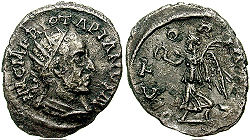This article needs additional citations for verification .(September 2025) |
| Jotapian | |||||||||
|---|---|---|---|---|---|---|---|---|---|
| Usurper of the Roman Empire | |||||||||
 Antoninianus of Iotapian. The obverse inscription reads imcmfr iotapianus av. | |||||||||
| Reign | c. 249 (against Philip the Arab) | ||||||||
| Predecessor | Philip the Arab | ||||||||
| Successor | Philip the Arab | ||||||||
| Born | Near East | ||||||||
| Died | c. 249 | ||||||||
| |||||||||
Jotapian ( /dʒəˈteɪpiən/ ) or Iotapian (Latin : M(arcus) F(ulvius) Ru(fus) Iotapianus; died c. 249) was an usurper in the eastern provinces of the Roman Empire during the reign of Emperor Philip the Arab, around 249. Jotapian is known from his rare coins and from accounts in Aurelius Victor (Caesares xxix.2), Zosimus (i.20.2 and i.21.2), and Polemius Silvius ( Laterculus ).